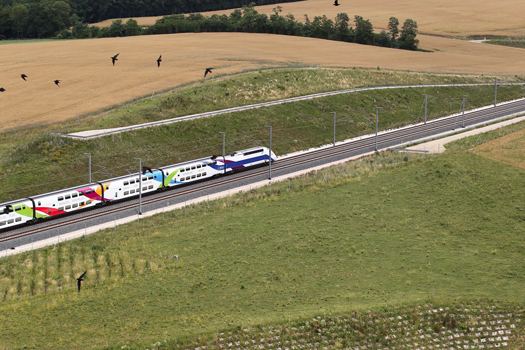Opened 11 December 2011 | ||
 | ||
Status Operational, partly under construction Stations | ||
Viaduc de la savoureuse lgv rhin rh ne mai 2010
The LGV Rhin-Rhône (Ligne à Grande Vitesse) is a high-speed railway line, the first in France to be presented as an inter-regional route rather than a link from the provinces to Paris, though it actually is used by some trains to/from Paris. The first phase of the eastern branch opened on 11 December 2011. Construction of its second phase was expected to start in 2014 but has unclear funding at this stage.
Contents
- Viaduc de la savoureuse lgv rhin rh ne mai 2010
- Map of LGV Rhin RhC3B4ne France
- Eastern branch
- Finance
- Construction
- Journey times
- References
Map of LGV Rhin Rh%C3%B4ne, France
If completed, LGV Rhin-Rhône would have three branches:
The construction of the latter two branches and of the second phase of the Eastern branch is currently unfunded.
Running north-south, the Southern branch line would help connect Germany, the north of Switzerland, and eastern France on the one hand with the valleys of the Saône, Rhône, the Mediterranean arc and finally Catalonia on the other. The east-west Eastern and Western branches lines would help connect on the one hand London, Brussels, Lille and Île-de-France (i.e., Paris and surroundings) with Burgundy, Franche-Comté, south Alsace, southern Baden, and Switzerland on the other.
A connection will be built at Perrigny, south of Dijon, to serve TGV and freight trains. Auxon station will be connected to Besançon-Viotte station by a railway line which could be also used for commuter trains.
It is projected that 12 million passengers per year will use the LGV Rhine-Rhône service.
Eastern branch
The first phase of the eastern branch runs 140 km (87 mi) of the 190 km planned length, connecting Villers-les-Pots (east of Dijon) to Petit-Croix (southeast of Belfort), was officially opened by President Nicolas Sarkozy on 8 September 2011, with passenger services starting on 11 December 2011.
The eastern branch is used by TGV trains operated by SNCF, the French national railway company. It will become a key link in both the North-South and East-West transport corridors. The line carries regional, national, and intra-European traffic. Mulhouse provides connection to Basel, Switzerland, and then to southwestern Germany and northwestern Switzerland.
Finance
The financing agreement for the first phase of the eastern branch was signed on 28 February 2006. The estimated cost of the first section of the eastern branch is 2.312 billion euros, shared between many organisations.
The largest contributors of funds are the Government of France (€751 million), the maintainer of the French rail network RFF (€642 million) and the European Union (€200 million). Significant funding also came from the three regions of France that the line travels through: Franche-Comté (€316 million), Alsace (€206 million) and Burgundy (€131 million). A further €66 million was funded by the Government of Switzerland.
Construction
Preparatory works began in 2005, and construction officially started on 3 July 2006 with a ceremony in Les Magny, Haute-Saône. Actual construction of the first section started north of Besançon on 7 August 2006.
Réseau Ferré de France appointed French engineering and consulting companies Setec and Egis to build the line. The construction of the Eastern branch was divided into two sections :
Journey times
Upon completion of the first section of the eastern branch, best journey time are:
